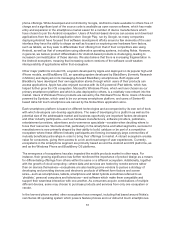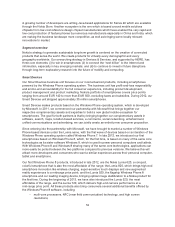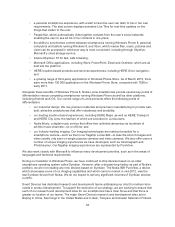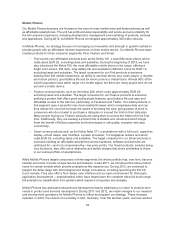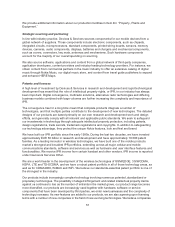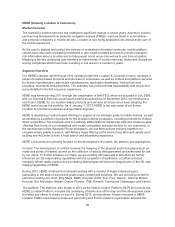Nokia 2012 Annual Report Download - page 52
Download and view the complete annual report
Please find page 52 of the 2012 Nokia annual report below. You can navigate through the pages in the report by either clicking on the pages listed below, or by using the keyword search tool below to find specific information within the annual report.phone offerings. While developed and controlled by Google, Android is made available to others free of
charge and a significant part of the source code is available as open source software, which has made
entry and expansion in the smartphone market easier for a number of device manufacturers which
have chosen to join the Android ecosystem. Users of Android-based devices can access and download
applications from the Android application store Google Play, run by Google, so many companies
deploying Android have focused their software development efforts around a few elements of the user
interface they have the ability to shape as well as focused on exploring new hardware form factors,
such as tablets, as they seek to differentiate their offering from that of their competitors also using
Android, as well as that of competitors using alternative operating systems, including Nokia. However,
in general, we believe product differentiation for Android-based products is challenging, leading to
increased commoditization of those devices. We also believe that there is increasing fragmentation in
the Android ecosystem, meaning that increasing custom versions of the software could weaken
interoperability of applications within that ecosystem.
Other major platforms include iOS, a system developed by Apple and deployed on its popular high-end
iPhone models, and BlackBerry OS, an operating system developed by BlackBerry (formerly Research
in Motion) and deployed on its messaging-focused BlackBerry smartphones. Both Apple and
BlackBerry have developed their own application stores through which users of their products can
access applications. Apple has also enjoyed success with its iOS-powered iPad tablets, which has
helped further grow the iOS ecosystem. Microsoft’s Windows Phone, which we have chosen as our
primary smartphone platform and which is also deployed by others, is a relatively new entrant into the
market. Users of Windows Phone products are served by the Windows Phone Store. Users of devices
powered by Symbian, which used to be our primary smartphone platform, and users of Series-40
based Asha full touch smartphone are served by the Nokia Store application store.
Each smartphone platform is based on different technologies and accompanied by its own set of tools
with which developers can develop applications. The ease of developing for a platform as well as the
potential size of the addressable market and business opportunity are important factors developers
and other industry participants—such as hardware manufacturers, software providers, publishers,
entertainment providers, advertisers and e-commerce specialists—consider when deciding where to
focus their resources. We believe that, particularly in the smartphone and tablet segments, success for
manufacturers is now primarily shaped by their ability to build, catalyze or be part of a competitive
ecosystem where these different industry participants are forming increasingly large communities of
mutually beneficial partnerships in order to bring their offerings to market. A vibrant ecosystem creates
value for consumers, giving them access to a rich and broad range of user experiences. Currently,
ecosystems in the smartphone segment are primarily based around the Android and iOS platforms, as
well as the Windows Phone and BlackBerry OS platforms.
The emergence of ecosystems has also impacted the mobile products market in other ways. For
instance, their growing significance has further reinforced the importance of product design as a means
for differentiating offerings from others within the same or a different ecosystem. Additionally, together
with the growth of cloud computing—where data and services are hosted by remote servers rather
than on devices themselves—ecosystems are also leading some vendors to pursue a strategy of
developing and providing devices and electronic products of different form factors and screen
sizes—such as smartphones, tablets, smartphone and tablet hybrids sometimes referred to as
‘phablets’, personal computers and televisions—and software which make them compatible and
support their seamless interaction with one another. As consumers acquire combinations of multiple
different devices, some may choose to purchase products and services from only one ecosystem or
vendor.
In the low-end phone market, other ecosystems have emerged, including that based around Nokia’s
own Series 40 operating system which powers feature phones and our Asha full touch smartphones.
51












